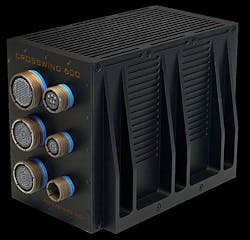Six-slot 3U VPX rugged computer chassis for avionics and vetronics offered by PCI Systems
SUNNYVALE, Calif., 18 Oct. 2012. PCI Systems Inc. in Sunnyvale, Calif., is introducing the Crosswind 600 six-slot 3U VPX rugged embedded computing chassis for avionics, vetronics, and other military embedded systems.
The Crosswind 600 chassis weighs 10 pounds and uses a PCI Express Gen2 modular active mezzanine backplane. The conduction-cooled chassis can dissipate 400 Watts in a non-moving air environment.
The fin design and wall thickness was analyzed with Flowmetrics software and designed for minimum delta T offset in an average thermal load application, PCI Systems officials say.
Designers used the VITA REDI specification to build the chassis, as well as for the thermal layout of the circuit board. The chassis also has large copper planes in the circuit board.
Options include thermally attaching modules module to a sidewall of the chassis to give one or more chips a heat travel path from the top of the chip.
Story continues below
Related stories
Small form factors shrink rugged embedded computing
Bandwidth demands of radar and signals intelligence create pressure to refresh XMC and FMC mezzanine board standards
OpenVPX conduction cooled PCI Express cable link boards introduced by PCI Systems for VPX test and measurement.
Other features include NEMA 4x IP65 sealing; GORE vents for atmospheric pressure equalization; void fillers for condensation control; COAX duct routing front I/O from card to card to rear I/O; MIL-DTL-38999 connectors; custom I/O; and cold-plate mounting.
Circuit board are IPC class 3 with conformal coating. The chassis also has a distributed PCI Express 100 MHz clock; Amphenol rugged VPX connectors available; passive backplane with active mezzanine; and a custom mezzanine for OpenVPX slot profiles.
For more information contact PCI Systems online at http://pcisystems.squarespace.com.

